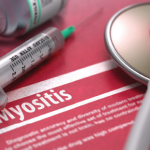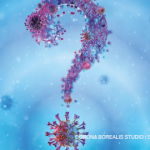 Rheumatologists use a broad range of autoantibody specificities to phenotype myositis and guide care of patients with the disease. Globally, line blot assays are increasingly used to test for autoantibodies. Unfortunately, these tests can result in false positives and negatives. Because no gold standard exists for autoantibody testing, clinicians often have difficulty recognizing false results. Those who suspect borderline-positive or low-positive levels of some antibodies are false positive are, therefore, left to interpret those results within clinical context.
Rheumatologists use a broad range of autoantibody specificities to phenotype myositis and guide care of patients with the disease. Globally, line blot assays are increasingly used to test for autoantibodies. Unfortunately, these tests can result in false positives and negatives. Because no gold standard exists for autoantibody testing, clinicians often have difficulty recognizing false results. Those who suspect borderline-positive or low-positive levels of some antibodies are false positive are, therefore, left to interpret those results within clinical context.
Despite this uncertainty, rheumatologists use blood tests to diagnose myositis, which means, absent a positive blood test, diagnosis is difficult. The challenges of diagnosing myositis are compounded by the fact that myositis is a general term describing multiple rare diseases. Moreover, myositis patients can have distinct presentations, and the disease can evolve over time. As a result, patients may accrue signs and symptoms of disease over a year or two and may visit three or four rheumatologists before being diagnosed. Reliable antibody panels may decrease the interval from symptom onset to diagnosis.
Christopher A. Mecoli, MD a rheumatologist at the Johns Hopkins University School of Medicine, Baltimore, and colleagues compared an increasingly used line blot array, Euroimmun Autoimmune Inflammatories Myopathies 16 Antigen platform, with the Oklahoma Medical Research Foundation Myositis panel (OMRF). The OMRF autoantibody panel is considered by many myositis experts to be the clinical gold standard antibody test. It uses several different assays, such as immunodiffusion, indirect immunofluorescence, immunoprecipitation of 35S-methionine-labeled proteins from cell extracts and RNA-immunoprecipitation to read out antibodies. The OMRF panel tests for autoantibodies recognizing Jo-1, Mi2, SRP, PM/Scl, PL-7, PL-12, Ku, EJ and OJ. The Euroimmun platform is a research assay and tests for Mi2α, Mi2β, PM/Scl75, PM/Scl100, Ku, Jo-1, SRP, PL-7, PL-12, EJ, OJ, TIF1γ, MDA-5, NXP-2, SAE and Ro52.
The rheumatologists at Johns Hopkins regularly review clinical data in parallel with research data to identify patterns in discordant results. In this study, the researchers analyzed serum samples (N=281) from The Johns Hopkins Myositis Cohort, a prospective myositis cohort of patients with autoimmune myositis. The results of the study were published online Aug. 20 in Arthritis & Rheumatology.1
The investigators used both OMRF and Euroimmun assays to test the blood sample from each patient. Approximately, one third of the samples tested positive by OMRF. Using the Euroimmun standard positive cutoff of greater than 15, approximately half of the samples tested positive for at least one antibody on the Euroimmun panel. Thus, some patients (n=18) were positive according to the Euroimmun assay, but negative according to OMRF.



